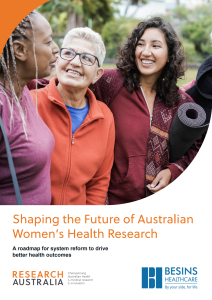R esearch Australia, in partnership with Besins Healthcare Australia, has officially launched a report Shaping the Future of Australian Women’s Health Research Roadmap.
esearch Australia, in partnership with Besins Healthcare Australia, has officially launched a report Shaping the Future of Australian Women’s Health Research Roadmap.
The launch event, hosted by the Centre for Sex & Gender Equity in Health & Medicine at the George Institute of Global Health yesterday, included prominent national and international leaders and speakers from across the sector, elevating the urgency and need for structural reform.
The Report presents a roadmap to enable a collaborative, equitable, and impactful health research environment, with the ultimate goals of improving health outcomes, advancing social and economic equity, and enhancing research excellence in Australia. The roadmap adheres to the National Women’s Health Agenda priorities and should be incorporated into the National Health and Medical Research Strategy.
Whilst Australian women enjoy one of the highest life expectancies globally, they spend approximately 14% of their lifetimes—that’s 12 years—in ill-health, and are affected by deeply entrenched gender biases and structural barriers in health and medical research. For First Nations women, women with disability, women who live in our regions, rural or remote areas, LGBTQI+ communities, as well as many from culturally and linguistically diverse backgrounds – health outcomes are even more stark.
Women’s health research has been historically underfunded in health and medical research. The report which includes a policy landscape presents a roadmap for the structural reforms required to deliver the high-quality, equitable and accessible health outcomes that Australian girls and women deserve. Key recommendations from the report, include:
• Building the systems, infrastructure, and partnerships needed to connect research, practice and policy for consistent, high-quality outcomes.
• (Re)defining women’s health so that we have a shared understanding of the broad scope of women’s health.
• (Re)-empowering the community to ensure research is shaped by the voices and lived experiences of women.
• Recognising and prioritising areas of need so that research is targeted and relevant.
Health equity begins with research equity. Strengthening research translation in women’s health requires sustained investment in systems and partnerships that link research, policy, and practice, support co-design and lived experience leadership, and ensure equitable access to the benefits of research for all women, girls, and gender diverse people across Australia.
“This report maps the structural changes needed to build a collaborative, equitable and genuinely impactful research environment for Australian women’s health”, Ms Nadia Levin, CEO & Managing Director of Research Australia said.
“The report highlights we need a research environment that strengthens women’s health outcomes, drives social and economic equality, and lifts Australia’s research excellence. This reform must span the whole pipeline, with partnership across research, philanthropy, clinicians, industry, community and government”.
Read the full report here.
Research Australia thanks those who contributed to this report, including sponsors of the project – Besins Healthcare Australia. We thank also the Centre for Sex & Gender Equity in Health & Medicine, George Institute of Global Health for their in-kind donation in hosting the event.
 Nearly 30% of Australians live in regional, rural, remote or very remote (RRRvR) communities, yet the funding for rural health and medical research is not comparable. RRRvR research, researchers, and research institutions excel in connectivity and co-design, establishing research priorities led by local needs and impactful service delivery models. Infrastructure such as regional universities, rural health departments and research institutes are essential to local communities – contributing to both healthier communities and a healthier local economies.
Nearly 30% of Australians live in regional, rural, remote or very remote (RRRvR) communities, yet the funding for rural health and medical research is not comparable. RRRvR research, researchers, and research institutions excel in connectivity and co-design, establishing research priorities led by local needs and impactful service delivery models. Infrastructure such as regional universities, rural health departments and research institutes are essential to local communities – contributing to both healthier communities and a healthier local economies.
 esearch Australia, in partnership with Besins Healthcare Australia, has officially launched a report Shaping the Future of Australian Women’s Health Research Roadmap.
esearch Australia, in partnership with Besins Healthcare Australia, has officially launched a report Shaping the Future of Australian Women’s Health Research Roadmap.